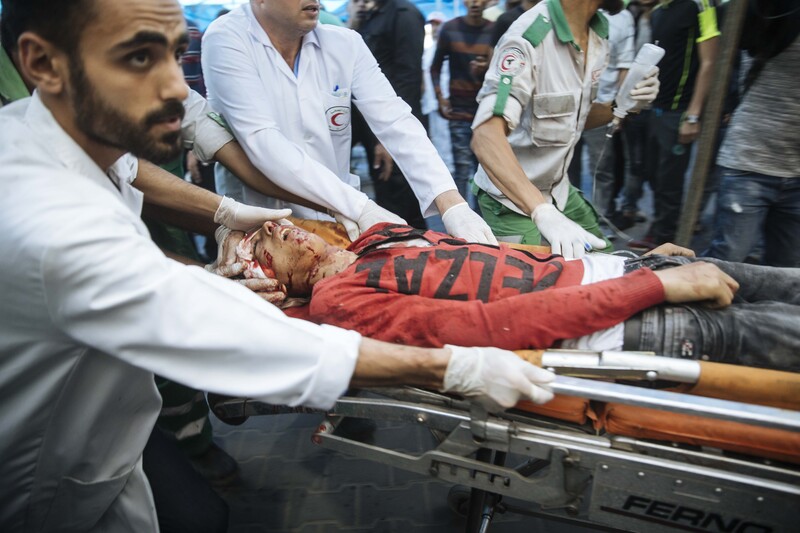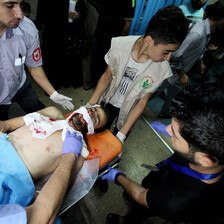The Electronic Intifada 7 June 2018

Medics at al-Shifa hospital in Gaza City transport a Palestinian wounded by Israeli troops during Great March of Return rallies, on 14 May. Health authorities say that on that day Gaza witnessed a worse health crisis than during any single day in Israel’s 2014 offensive on the territory.
SIPAAs the dust settles over Gaza, an already wobbling Egyptian-mediated ceasefire may bring some calm for the two million Palestinians trapped there without, yet again, any resolution to Gaza’s underlying problems.
The most pressing problem for Palestinians in Gaza remains a tottering infrastructure that threatens a full-blown humanitarian catastrophe at any moment. Water and electricity are scarce, sewage flows directly into the sea and the economy is in ruins.
The health sector has been the focus over the past few weeks since the Great March of Return protests put the spotlight back on Gaza.
The number of injuries resulting from Israeli attacks against unarmed protesters on the eastern boundary of the Gaza Strip nearly broke the back of an overstretched and under-resourced sector, exacerbating the pressure on health professionals and straining provision.
Medics even found themselves in the crosshairs, and two – Razan al-Najjar on 1 June and Mousa Jaber Abu Hassanein on 14 May – were killed while carrying out their duties.
The highest casualty count of the Great March of Return came on 14 May, and was followed by more protests – and more wounded – on 15 May. Both days brought with them shocking scenes at Gaza Strip hospitals.
With a huge number of wounded – more than 3,100 over those two days alone – there were no available beds and people were being treated in hallways or even at hospital entry gates.
There was an acute shortage of medicine and supplies, according to Ashraf al-Qedra, a health ministry spokesperson, who said hospitals had used 80 percent of ministry stores during those days.
“This crisis caused a huge deficit in hospitals in the Gaza Strip. Patients who seek public hospitals for treatment, cannot find the medical care they need due to hospitals overwhelmed with injuries,” al-Qedra told The Electronic Intifada.
Delays bring amputation, pain
Ahmad Shahin, 24, was shot in his left foot during protests on 14 May. He found himself writhing in pain in a corridor at Gaza City’s al-Shifa hospital, where operating theaters were too busy to take him in.
He was then transferred to al-Awda hospital, where he spent another night in agony before finally getting surgery.
By then his condition had become critical following an infection in his wound.
“I waited six hours for surgery,” Shahin, who lives in the Jabaliya refugee camp, told The Electronic Intifada. “My father had to buy a painkiller injection, because the hospital had run out. After surgery I found that my leg was amputated [below the knee], otherwise the infection would have spread.”
Hamza Rayan, 19, was shot near the neck on 15 May, paralyzing him in all four limbs. He was injured, he said, when trying to save his friend, Ahmad Hassan, also 19, who had been wounded. Until his father, Ayman, 45, told him in hospital that Hassan had been shot in his foot, Hamza did not know whether his friend was alive.
As in Shahin’s case, Hamza had to rely on his father to bring medical supplies that had run out in al-Shifa hospital. The elder Rayan bought fluids from an external pharmacy but he could not afford the cost of antibiotics or painkillers.
“I was one of dozens of people who had to buy medicines from outside pharmacies,” Ayman Rayan told The Electronic Intifada. “But I am unemployed. I was able to manage five saline solutions but now I can’t any more, and my son needs three saline solutions, painkillers and antibiotics on a daily basis.”
Hamza’s father has been forced to borrow money to cover the cost of his son’s medical needs. He buys from a local non-governmental organization, the Palestinian Medical Relief Society, and estimates the cost at $28 a day.
The World Bank has calculated the average annual income in Gaza in 2018 to be $1,826, which works out to $5 a day.
Normal service disrupted
With such an overwhelming number of emergencies, those seeking more routine medical care were shunted to the back of a queue that is still not cleared.
Mustafa al-Reyes, 27, suffered an intestinal infection on 19 May. But when he went to al-Shifa hospital, doctors turned him away, apologizing that they had no available beds, and urged him to seek treatment at a private hospital.
“We were shocked to see the number of injuries,” his brother Muhammad told The Electronic Intifada. “My brother was in pain. He asked me to take him to a private clinic where he received the required medical treatment.”
But private care is no answer in Gaza, where the vast majority of those seeking medical attention cannot afford it.
And public hospitals remain overwhelmed. Ayman al-Sahbani, head of al-Shifa’s emergency department, pointed out that many of the serious injuries from across the Gaza Strip have been transferred to al-Shifa, the Gaza Strip’s largest hospital and the one with the most specialists.
Many of those waiting for follow-up surgeries are still waiting, said al-Sahbani.
“The wounded consume double the medical care than normal patients, and some of our medical stores are empty,” said al-Sahbani. “International institutions help by sending emergency supplies, but it is not enough. We are still waiting for some medical supplies promised by international institutions.”
Outside help – from governments and international NGOs like Medical Aid for Palestinians, the International Committee of the Red Cross and Médecins Sans Frontières – has been widely sought, according to al-Sahbani.
Some NGOs already have a presence on the ground and medical teams have arrived from Jordan to help their colleagues in Gaza as well as to refer injuries to Jordan.
Abdel Latif al-Hajj, the general director of Gaza’s hospitals in the health ministry, said the sector struggled to cope on 14 May, a day he said that witnessed a worse health crisis than during any single day in the 2014 Israeli offensive on Gaza.
Near collapse
“The medical system almost collapsed on 14 May,” al-Hajj told The Electronic Intifada. “No health system can accommodate such a huge amount of injuries, but we fought to provide medical service, both in the emergency rooms where we added additional beds, in tents erected outside hospitals, and medical tents in the field that could deal with minor injuries.”
According to al-Hajj, 80 operations were performed at al-Shifa hospital in six hours on 14 May. In all, he said, during those fateful hours, Gaza’s seven government hospitals performed more than 250 operations.
“International doctors from the Red Cross, Doctors Without Borders, Medical Aid for Palestinians and others worked with us. All of them said they had never witnessed such a huge amount of suffering and brutality in their work in areas of conflict around the world,” said al-Hajj.
Hospitals are only just beginning to receive non-emergency patients, who have also suffered the consequences.
“There is a crisis for cancer patients. More than 80 percent of 8,000 patients have no access to chemotherapy, and most cannot leave the Gaza Strip for treatment,” said al-Hajj.
He notes that the health sector still lacks all types of antibiotics, intravenous solutions, anesthetics and powerful analgesics, as well as anticoagulants, which are considered a priority, in addition to general lab supplies and emergency tools such as surgical threading for fine surgery.
Ahmad Abu Sakran, 22, was shot in the shoulder during the 14 May protests. Much to his surprise, he was admitted for treatment at al-Shifa, even as the wounded flooded in.
“I was terrified to see the number of wounded,” he told The Electronic Intifada. His father also had to buy painkillers from a nearby pharmacy to alleviate his son’s discomfort.
“Every time I remember the scene I am shocked to remember the suffering that day.”
Amjad Ayman Yaghi is a journalist based in Gaza.





